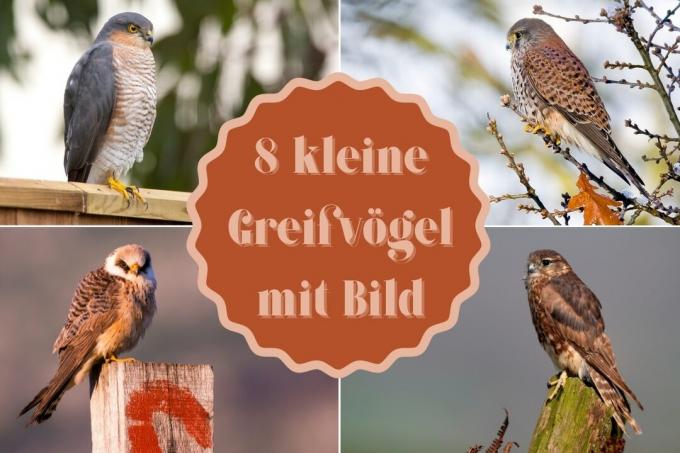
table of contents
- 8 small birds of prey
- Hawks
- Tree falcon (Falco subbuteo)
- Merlin (Falco columbarius)
- Red-footed falcon (Falco vespertinus)
- Kestrel (Falco tinnunculus)
- Sparrowhawk (Accipiter nisus)
- Consecration
- Hen harrier (Circus cyaneus)
- Marsh harrier (Circus aeruginosus)
- Montagu's Harrier (Circus pygargus)
- frequently asked Questions
You can often see them majestically circling in the sky: birds of prey. But what kind is it exactly? We introduce you to eight small, native species in more detail.
In a nutshell
- Birds of prey are diurnal birds of prey
- hit their prey with clawed feet
- the most common small bird of prey is the kestrel
- is often found in villages and towns, nests on church towers
- The sparrowhawks, which are reminiscent of small hawks, are also common
8 small birds of prey
Birds of prey are birds of prey and are only active during the day. The strong, clawed feet with which the birds grab and kill their prey are typical of all species of birds of prey. That is why the species in this group are also referred to as “predators”. The prey is chopped up with the strong, downwardly curved and sharp beak. The sharp eyes recognize the prey from a great distance and, in the case of the osprey, even underwater.
Note: A total of 22 different species of birds of prey live in Germany. However, depending on the region, most of them are rarely found: more than every second predator sighted is either a kestrel or a buzzard.
Hawks
The long tail and the pointed wings are typical of all falcon species. All falcons also have what is known as a falcon tooth, which is a jagged shape on the front part of the hook-shaped upper beak. Hawks have large, mostly dark eyes and, unlike the larger griffins, are active fliers. While hawks and buzzards mainly use the updraft to fly, falcons move through the air using their own muscle power. Another difference from other birds of prey is that falcons do not build nests. Instead, hawk parents breed in abandoned nests of other birds or in natural hollows on buildings (such as the kestrel), on trees (tree falcon) or on rock walls.
Tree falcon (Falco subbuteo)
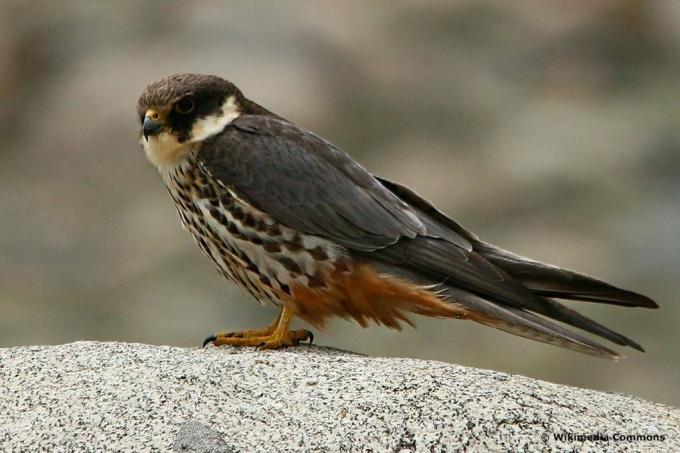
- Body length: 30 to 36 centimeters
- Wingspan: 70 to 85 centimeters
- Weight: 140 to 350 grams
- Color: upper side dark brown to bluish, head with a dark streak of beard that contrasts sharply with the white cheek and light throat, underside light with strong, black vertical lines
- Migratory bird: long-distance migrant, overwinters in Africa and South Asia
- Shout: pointed, high "kikiki" in long rows of shouts
- Special features: the rust-colored "pants" in adult animals are typical of the species
Note: The tree hawk is not very common and is an endangered species.
Merlin (Falco columbarius)
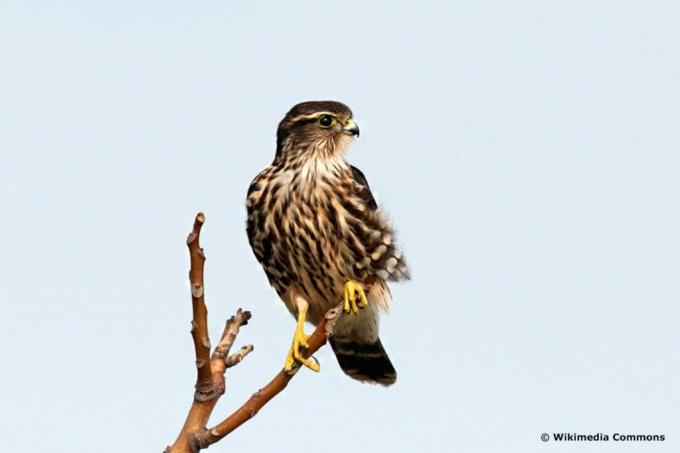
- Body length: males 25 to 30 centimeters, females significantly larger
- Wingspan: Males about 60 centimeters, females up to 67 centimeters
- Weight: about 190 grams
- Coloring: males slate-gray upper side, rust-colored neck area, light to rust-colored underside with dark spots, gray tail with black end band; Females dark brown upper side, white, dark spotted underside, dark banded tail
- Migratory bird: yes, breeds in Northern Europe and winters in Central Europe
- Call: rarely heard in winter quarters, but closely resembles the call of the kestrel
- Special characteristics: pronounced sexual dimorphism, ground breeder
Red-footed falcon (Falco vespertinus)
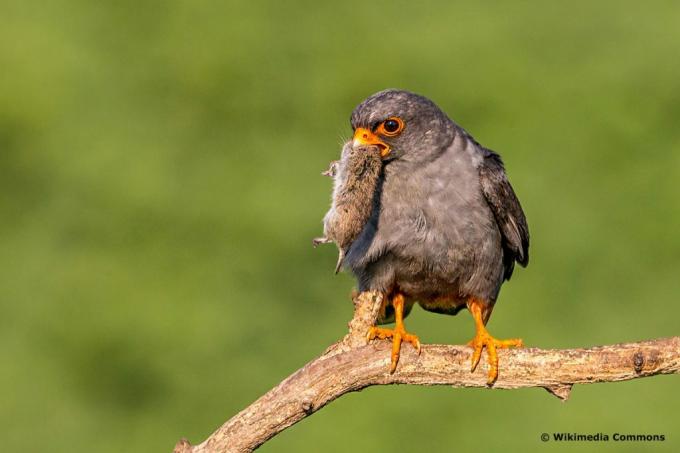
- Body length: 29 to 31 centimeters
- Wingspan: 60 to 75 centimeters
- Weight: males 115 to 190 grams, females 130 to 197 grams
- Coloring: varies according to age, old male birds are solid dark slate gray with black tail, red "pants" and under tail-coverts, bright red feet and narrow red ones Eye ring; female birds are more inconspicuously colored
- Migratory bird: breeds v. a. in the Hungarian lowlands, is sometimes in Germany as a summer guest as well as v. a. to watch in spring and autumn
- Call: similar to the tree hawk, but higher and slower ("kjiiie-kjiie")
- Special characteristics: juvenile, not yet colored specimens are easily mistaken for the tree falcon
Kestrel (Falco tinnunculus)
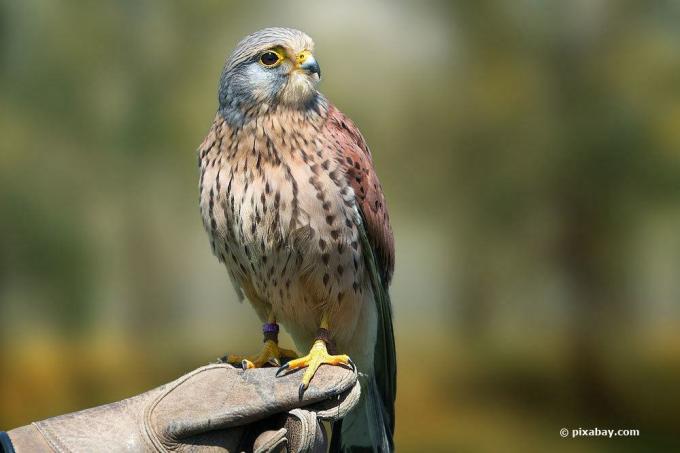
If you see a small bird of prey, especially if it's in or near built-up areas, it's likely a kestrel. The kestrel is very versatile in the choice of its breeding site: it uses old nests of crows and magpies on trees or high-voltage pylons, but also breeds in rock and building niches. The species likes to colonize church towers and other structures within localities.
- Body length: 32 to 39 centimeters
- Wingspan: 65 to 82 centimeters
- Weight: about 200 grams
- Coloring: pronounced sexual dimorphism, males red-brown, darkly spotted upper side, chest also densely spotted, tail gray with black end band, brownish head
- Migratory bird: standing bird
- Reputation: penetrating ki-ki-ki-ki-ki ...
- Special features: typical is the shaking flight, whereby the bird "stands" in the air with a fanned tail, flaps its wings quickly and looks for prey
Sparrowhawk (Accipiter nisus)

In contrast to the very persistent falcons, which can persistently pursue their prey over long distances, The sparrowhawk can only pursue its own - mostly small birds - briefly and therefore has to make surprise attacks start.
- Body length: 28 to 38 centimeters
- Wingspan: 55 to 70 centimeters
- Weight: male approx. 140 grams, females approx. 230 grams
- Coloring: male bluish gray upper side, reddish brown banded lower side; Female gray-brown upper side, white underside with black banding
- Migratory bird: standing bird
- Call: long series of calls, also in the duet "gi-gi-gi-gi ..."
- Special characteristics: yellow eyes
Note: Sparrowhawks are easy to confuse with the related hawk, especially when in flight. However, with a wingspan of up to 165 centimeters, this is significantly larger and also more massive.
Consecration
The harriers also belong to the hawk-like family of birds of prey (Accipitridae) and are thus related to the sparrowhawk and hawk. They are medium-sized, very slender birds of prey with long and wide wings. Typical for all types of consecration is a rocking search flight, in which the bird flies with wings raised in a V shape close to the ground and "rocks" around its own axis.
Hen harrier (Circus cyaneus)
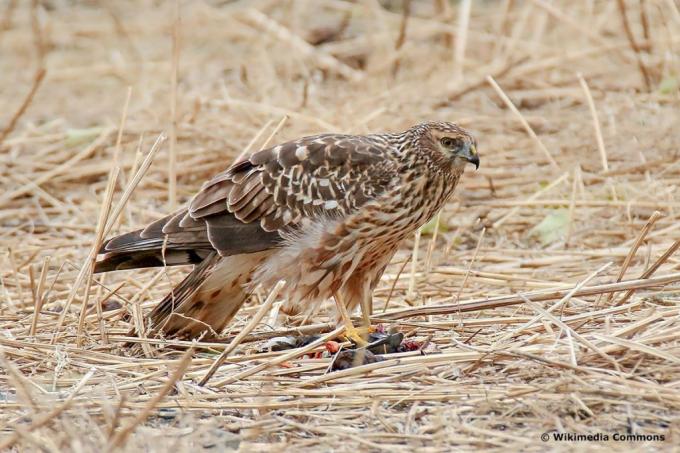
- Body length: 42 to 55 centimeters
- Wingspan: 97 to 118 centimeters
- Weight: males up to 400 grams, females a little heavier
- Coloring: males very lightly colored with a light bluish-gray upper side, light gray head and front body, white underside, black wing tips; Females and young animals, on the other hand, are brown with a longitudinally striped underside
- Migratory bird: depending on the occurrence, resident bird up to long-distance flyer
- Reputation: very different between the sexes
- Special characteristics: is on the red list of endangered species in Germany, only a few breeding pairs left
Marsh harrier (Circus aeruginosus)
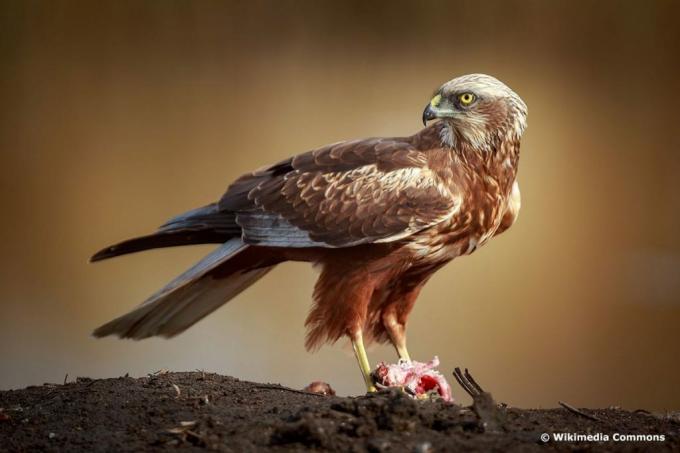
- Marsh harriers mainly breed in reeds and on grain fields.
- Body length: 48 to 56 centimeters
- Wingspan: 110 to 130 centimeters
- Weight: male approx. 540 grams, females 740 grams
- Color: brown back with light brown head, wings brown-gray-black
- Migratory bird: medium or long-distance migrant
- Call: croaking calls during courtship flight; chuckling in case of danger
- Special features: noticeably long legs
Note: The nest is mainly built by the female, while the male brings the nesting material.
Montagu's Harrier (Circus pygargus)
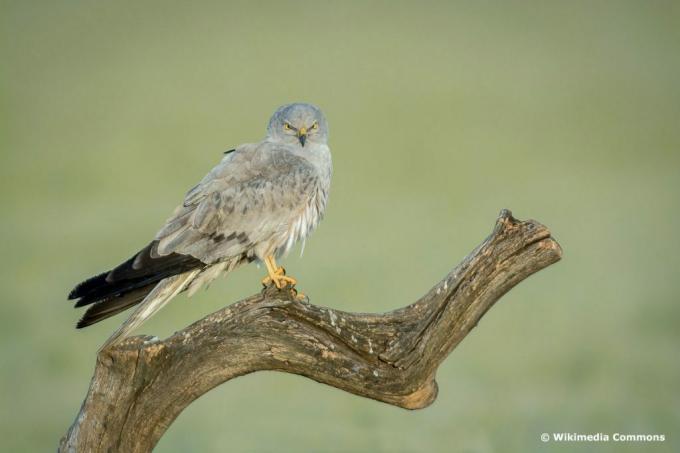
- Body length: 43 to 47 centimeters
- Wingspan: 105 to 120 centimeters
- Weight: around 300 grams
- Coloring: males monochrome dark gray, red-brown spotted belly; Females monochrome medium brown with a white rump
- Migratory bird: long-distance migrant
- Call: cheeky series of calls during courtship flight of the male, for example "kä-kä-kä"
- Special characteristics: breeds and hunts mainly in moors and meadows
Note: The Montagu's Harrier breeds on the ground, sometimes in loose colonies. In addition to mice, it eats large insects, Lizards and little birds.
frequently asked Questions
Owls are also birds of prey, but not birds of prey. Birds of prey are diurnal, while owls hunt at dusk and at night. The smallest native owl is the pygmy owl (Glaucidium passerinum), which is less than 20 centimeters long.
The Merlin is the smallest falcon in Europe and is native to northern Europe in particular. With us, the species is mainly encountered as a winter guest and during migration in spring and autumn.
Worldwide, the black buzzard (Buteogallus urubitinga) is probably the most common bird of prey. This can be found in large parts of Europe, Africa and Asia as well as in Australia and New Guinea. In Germany, both the buzzard and the kestrel are among the most common species.



